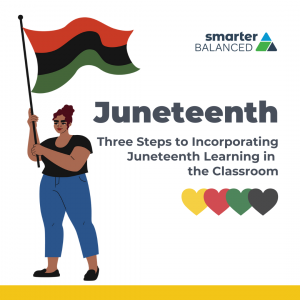Three Steps to Incorporating Juneteenth Learning in the Classroom

On June 19, 1865, a Union general named Gordon Granger arrived in Galveston, Texas, declaring that the Civil War was over and enslaved African Americans were free. This announcement solidified President Abraham Lincoln’s 1863 Emancipation Proclamation two and a half years later.
During Juneteenth, also known as “Freedom Day,” “African American Independence Day,” and “Jubilee Day,” we celebrate formal Black emancipation from the institution of slavery and recognize the struggles of all those enslaved and formerly enslaved in their fight for freedom.
While formally, U.S. slavery ended, it’s essential to recognize the consistent efforts needed to amplify African American voices to support racial equity in America. We hope the following resources help support your summer planning and inspire you to motivate your students to build and sustain change for a more inclusive future for all.
Step 1: Build Your Understanding
Learn about Juneteenth, what it represents, what it means for the Black community, and why your role as an educator can shape students’ understanding of United States history.
- What is Juneteenth?
So You Want to Learn About Juneteenth?
The New York Times describes the logistics behind the celebration of Juneteenth.
- Juneteenth’s History
History of Juneteenth
Juneteenth.com breaks down the history of the holiday and how it’s celebrated.
- Why We Highlight Juneteenth and its Significance
Why all Americans should honor Juneteenth
Vox explains the importance of all people learning about and honoring Juneteenth.
Step 2: Design Your Approach
Promote Juneteenth learning in the classroom to celebrate equality and create safe spaces for discussion.
- How to Approach Teaching Juneteenth
Teaching Juneteenth
Learning for Justice explains how Juneteenth should be approached and taught in the classroom.
- Activity Approach: Value Lines
Value Lines
Learning for Justice explains the Value Lines approach for in-class discussions.
- Activity Approach: Four Perspectives
Four Perspectives
Learning for Justice illustrates the Four Perspectives approach for in-class discussions.
Step 3: Use Great Lessons
Use these powerful lessons centered around Juneteenth to highlight the struggle for Black emancipation and the holiday’s national recognition.
- Activities
Juneteenth | All About the Holidays
This quick video for grades K-5 is about the origin and basics of Juneteenth.
- Should We Honor Juneteenth?
Should Juneteenth Be a National Holiday? By PBS NewsHour
This five-minute PBS video provides a questions and answers session with professor Mark Anthony Neal followed by questions about the meaning of Juneteenth from a reading by Henry Louis Gates Jr.
- Juneteenth Colorful Pages
Juneteenth Worksheet
The Juneteenth worksheet is a brief activity for students to summarize what Juneteenth is and why we celebrate it.
